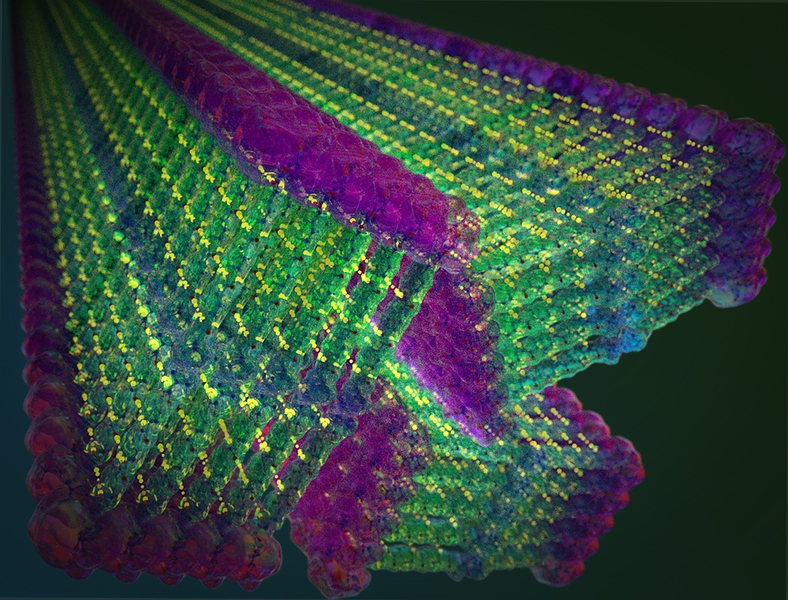(Researchers construct molecular nanofibers that are stronger than steel)
2021/1/25 アメリカ合衆国・マサチューセッツ工科大学(MIT)

・ MIT が、これまでにない強度を有するナノリボンへと自己集合し、乾燥後も全体構造を維持するアラミド両親媒性物質による小分子プラットフォームを開発。
・ DNA の 2 本の鎖による二重らせんの形成や、無数の分子が寄り集まってメンブレンを構成するなど、自己集合は有機体で組織化した構造を形成する手段として自然界のあらゆる場所に存在する。
・ これに倣い、特に薬物伝達や組織工学等のバイオ医療アプリケーション向けたナノ構造体の開発を主要な目標として、水溶液中で自己集合してナノ構造体を形成する分子の設計が試みられている。しかし、このようなナノ構造体は劣化が早く、乾燥すると化学的な安定性を損失しやすくなり、外部からの力で構造全体が崩壊する問題がある。
・ 今回、細胞膜をモデルに、外部が親水性で内部が疎水性をもつ構造の分子を作製。この構造が自己集合の駆動力を提供する。同分子は疎水性領域と水溶液との間の相互作用を最小限に抑えるように配向してナノリボンを形成する。
・ 分子の挙動は分子間の結合が緩まるほど速くなり、強くなるほど遅くなって固体に似た状態を帯びることから、結合を強化するアラミドを分子の中間部に取り入れることで分子の挙動を遅らせてナノリボンの特性を強化。これにより、乾燥後の構造体全体の崩壊を回避できた。
・ 同プラットフォームで作製した長いナノリボンの強度と硬度を測定し、強靱な材料の Kevlar に見られるような分子間の相互作用の効果を確認。同ナノリボンの強度が鋼よりも高いことを発見した。
・ 整列させたナノリボンを引き延ばし、乾燥後に束ねて安定したナノファイバーを作製。自重の 200 倍の重量を保持する力に加え、200 ㎡/g の極めて大きな表面積を提供する。鉛やヒ素等の重金属を汚染水から除去する分子でコーティングした表面をもつナノリボンを作製。束ねたナノリボンを電子デバイスや電池で利用することも検討している。次には最重要アプリケーションについて研究を進める。
・ 本研究は、米国立科学財団(NSF)、Professor Amar G. Bose Research Grant Program および Abdul
Latif Jameel Water and Food Systems Lab(J-WAFS)が支援した。
URL: https://news.mit.edu/2021/molecular-nanofibers-stronger-than-steel-0125
<NEDO海外技術情報より>
(関連情報)
Nature Nanotechnology 掲載論文(アブストラクトのみ:全文は有料)
Self-assembly of aramid amphiphiles into ultra-stable nanoribbons and aligned nanoribbon threads
URL: https://www.nature.com/articles/s41565-020-00840-w
Abstract
Small-molecule self-assembly is an established route for producing high-surface-area nanostructures with readily customizable chemistries and precise molecular organization. However, these structures are fragile, exhibiting molecular exchange, migration and rearrangement—among other dynamic instabilities—and are prone to dissociation upon drying. Here we show a small-molecule platform, the aramid amphiphile, that overcomes these dynamic instabilities by incorporating a Kevlar-inspired domain into the molecular structure. Strong, anisotropic interactions between aramid amphiphiles suppress molecular exchange and elicit spontaneous self-assembly in water to form nanoribbons with lengths of up to 20 micrometres. Individual nanoribbons have a Young’s modulus of 1.7 GPa and tensile strength of 1.9 GPa. We exploit this stability to extend small-molecule self-assembly to hierarchically ordered macroscopic materials outside of solvated environments. Through an aqueous shear alignment process, we organize aramid amphiphile nanoribbons into arbitrarily long, flexible threads that support 200 times their weight when dried. Tensile tests of the dry threads provide a benchmark for Young’s moduli (between ~400 and 600 MPa) and extensibilities (between ~0.6 and 1.1%) that depend on the counterion chemistry. This bottom-up approach to macroscopic materials could benefit solid-state applications historically inaccessible by self-assembled nanomaterials.



